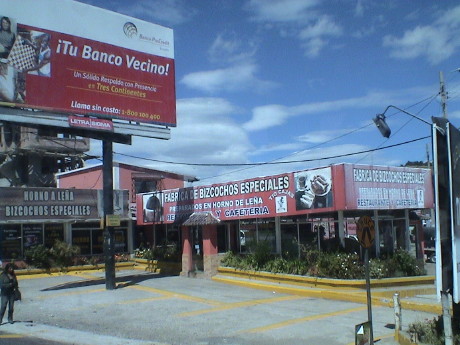 It seems that every third
building in Cayambe sells bizcochos. These are a sort of a fried
bread/pastry snack that is apparently popular here. We had some at the
Hacienda, they were ok but not outstanding. Maybe the ones in town are
better.
It seems that every third
building in Cayambe sells bizcochos. These are a sort of a fried
bread/pastry snack that is apparently popular here. We had some at the
Hacienda, they were ok but not outstanding. Maybe the ones in town are
better.There was no posting yesterday because Sandy and I were on the road. We were traveling light so se left our computers at the Hacienda, well locked up. We went back to Otavalo via public busses with 7 other women from the project. I was the only male in the group. Sandy got tired the last time and didn't get all the loot she wanted. This time, we had more time, but she still got pretty tired at the end, but at least she filled out her lists.
The trip involved two busses, the Cangahua bus took us to Cayambe. In Cayambe we found the terminal for the busses that run between Cayambe and Otavalo and that bus took us there.
Both rides together costs us $1/head. The busses here are cheap, run very frequently and are virtually always crowded. The riders that don't get on at the beginning of a run are usually standing.
Fortunately for us, we got seats on both of the Otavalo busses and on the Cangahua bus on the way back. Even more fortunately, our seats were behind the driver and our view forward was blocked by a partition so that I could not see the craziness going on on the road ahead.
 It seems that every third
building in Cayambe sells bizcochos. These are a sort of a fried
bread/pastry snack that is apparently popular here. We had some at the
Hacienda, they were ok but not outstanding. Maybe the ones in town are
better.
It seems that every third
building in Cayambe sells bizcochos. These are a sort of a fried
bread/pastry snack that is apparently popular here. We had some at the
Hacienda, they were ok but not outstanding. Maybe the ones in town are
better.
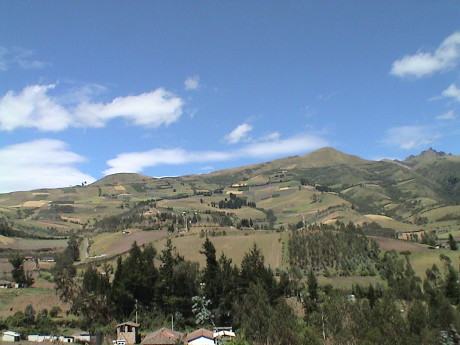 This photo is of some pretty
typical farmland on the way between Cayambe and Otavalo. The farm
houses ranged between reasonable looking structures with tile roofs to
ramshackle shacks that didn't look suitable for habitation. It is
pretty clear that much of the rural population is very poor.
This photo is of some pretty
typical farmland on the way between Cayambe and Otavalo. The farm
houses ranged between reasonable looking structures with tile roofs to
ramshackle shacks that didn't look suitable for habitation. It is
pretty clear that much of the rural population is very poor.
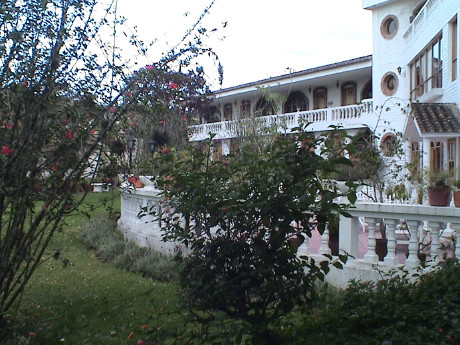 When we got to
Otavalo, we got off the bus and walked some distance down the Avenida
Quito to a walled compound which was the Hotel Ali Shungu. Inside the
compound was a very nice hotel that ran us $55 a night for a
double.
When we got to
Otavalo, we got off the bus and walked some distance down the Avenida
Quito to a walled compound which was the Hotel Ali Shungu. Inside the
compound was a very nice hotel that ran us $55 a night for a
double.
The hotel was run and probably owned by a couple named Frank and Margaret. Most of the signage was in english and the hotel was clearly set up for english speaking guests. There was wireless internet in the hotel so that we could surf the net on Sandy's iPod touch and on a single computer in the lobby. IE in Spanish is really frustrating, mostly because of the keyboard layout. I never did figure out how to type a colon and getting an @ sign was difficult. To get the colon, I surfed a few pages and found one with a colon on it and then copied and pasted the character onto the location bar when I needed it.
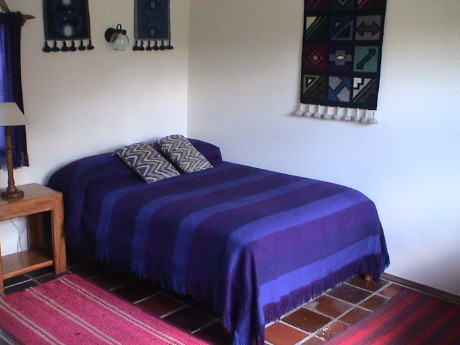 Our room was very nice
too. The door was heavy with a substantial lock. We also had an
electric heater which we ran almost all the time.
Our room was very nice
too. The door was heavy with a substantial lock. We also had an
electric heater which we ran almost all the time.
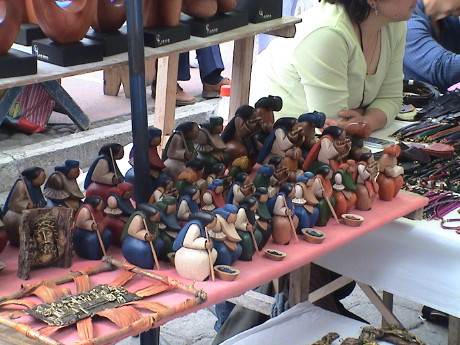 Many of the vendors that
I recognized from the last time were in the same spots as before. This
one was selling wooden figures representing the local population.
Many of the vendors that
I recognized from the last time were in the same spots as before. This
one was selling wooden figures representing the local population.
I walked Sandy around and carried her loot. She shopped literally until she dropped. She gets a really tired and pained expression on her face when she runs out of energy and it was time to quit.
I had only one shopping goal. This was to find a charger for Sandy's cell phone. The Juice70 that Sandy uses to charge her computer and other toys died. The only item that we have with us that we didn't have a redundant charging method for was her cell phone. I found a charger for $5 in a cell phone shop. There are Porta shops all over town. Virtually everybody here uses prepaid cell phones from Porta or Movistar (Sandy's has a Movistar SIM card in it). We found a shop that actually had hardware. He had dozens of generic chargers sitting in piles in his display cabinets. We found one that fit her phone and it worked so now we have a redundant charger as well. We'll get the Juice70 either fixed or replaced when we get back to the US.
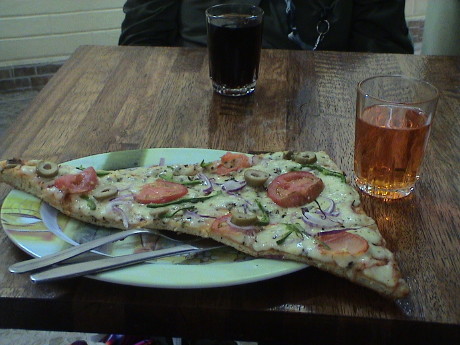 A good place to quit was a
pizza shop. The sign outside said they had a "mega" sized pizza and a
drink for $1.25. This was a good pizza but without tomato sauce. We
hung out in that shop until Sandy recovered her energy and then headed
back for the hotel where we took a nap.
A good place to quit was a
pizza shop. The sign outside said they had a "mega" sized pizza and a
drink for $1.25. This was a good pizza but without tomato sauce. We
hung out in that shop until Sandy recovered her energy and then headed
back for the hotel where we took a nap.
Around dinner time, we met up with two more PAP folks and we all had dinner in the hotel. The travel guide listed the hotel food as excellent. The 11 of us spent $165 for dinner and this included one or two drinks for most everybody but Sandy and I. She had water and I had a bottle of Fanta. The food was quite good and everybody seemed satisfied.
Sometime during dinner, somebody outside started firing off bottle rockets. These were not your lightweight ordinance, these were big and loud. We'd hear a whoosh, then a couple of seconds later, there would be a bright flash and a boom occurring virtually simultaneously. This means that the things were exploding either over or very close to the hotel. Each one would set off several car alarms. As each alarm timed out and reset, more rockets would set off other alarms such that car alarms were running almost constantly. This continued through the evening and then started up again the next morning.
It occurred to me that if you wanted to rip off cars, then this would be a good way to do it. After a few hours of this, nobody would be paying attention to car alarms anymore.
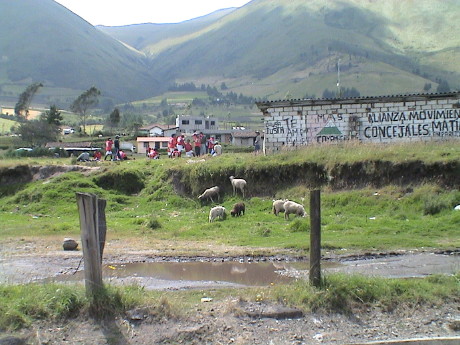 The next morning
our original group of 9 sort of split up on the return trip. I located
the bus terminal on the map and Sandy and I walked 7 or 8 blocks to the
terminal. We got on the bus with the guy yelling "Cayambe" and it left
in just a few minutes. On the way back, I caught a photo of this Sunday
morning soccer game with sheep grazing on the edge of the field.
The next morning
our original group of 9 sort of split up on the return trip. I located
the bus terminal on the map and Sandy and I walked 7 or 8 blocks to the
terminal. We got on the bus with the guy yelling "Cayambe" and it left
in just a few minutes. On the way back, I caught a photo of this Sunday
morning soccer game with sheep grazing on the edge of the field.
We got off at a stop in Cayambe which was a block from the Gran Aki market, bought some supplies (diet coke, chocolate, hot sauce and cookies). We then walked a couple of blocks to the Cangahua bus terminal and got on an empty bus to wait for it to leave. We got off at the Hacienda, paid our $0.25/head fare and were "home" again just after noon.
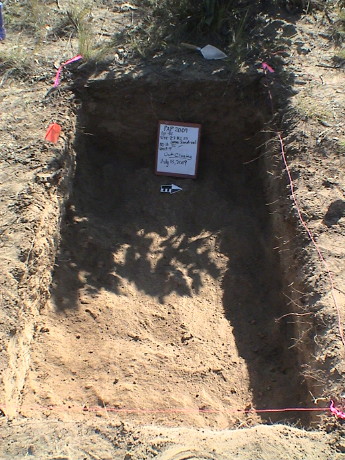 It's back to
work for today. I was back at Loma Sandoval doing some clean up on unit
6 to finally finish the close out process.
It's back to
work for today. I was back at Loma Sandoval doing some clean up on unit
6 to finally finish the close out process.
In the meantime, we opened a new unit, unit 9, in the northeast corner of the site. This is a small unit, a 1 x 2, looking for signs of habitation. We picked a spot roughly in the center of a surface artifact scatter field. There was literally thousands of broken pieces of pottery sitting on the surface over a large area. However, when we actually dug out the unit, we got some pottery in the first 10 cm or so then it petered out. We hit bedrock at about 20 cm. At this point, we were pretty sure that this area was not inhabited to any great extent. We needed to find out if this was really the bottom so one of the Ecuadorian workers picked through a very hard layer of Cangahua rock and we sifted everything. We didn't find anything until virtually the last bucket when some spheres a little larger than a ping pong ball showed up. There were also some pieces of spherical shells that fit over these pieces but they were very soft. Then we determined that they were probably made by a dung beetle a very long time ago.
Tomorrow, we'll start yet another unit somewhere near the ones that we have been working on.
Sandy is making progress in the lab, but slowly. She is having problems with location data that has systematic errors in it. Further, Google Earth appears to have errors in it as well resulting from bad data submitted by somebody on this project in some past year.
Last night after dinner, we had a lecture in the lecture hall. The son-in-law of the Hacienda owner, a fellow that goes by the name of Cabo, presented us with his view of "astro archaeology." He is studying the way that the pre-Inka residents of the area studied the stars and tracked the seasons. There are a bunch of similar sites all around the Pambamarca area that consist of a flat circle of cobblestones. Most of these are on or near hilltops. At the solstices and equinoxes the first or last sunlight of the day shining over particular low spots in the mountains that form the horizon will cast a shadow of a man directly across the circle. Since these sites are all in the Andean highlands and at or near the equator, they have a particular view of the sky that cannot be obtained anywhere else. The pre-Inka people had pinned the location of the equator virtually perfectly via only the movements of the stars and sun as observed by eye.
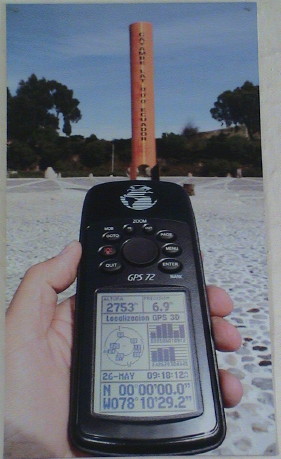 After
the lecture, we were loaded up on a bus for a ride to the Mitad del
Mundo (middle of the world) monument that sits right on the equator.
This is a photo of the site in the daytime showing the GPS location.
The site is right along the Pan American Highway about a half a mile
from the junction of the highway and the road to Cangahua.
After
the lecture, we were loaded up on a bus for a ride to the Mitad del
Mundo (middle of the world) monument that sits right on the equator.
This is a photo of the site in the daytime showing the GPS location.
The site is right along the Pan American Highway about a half a mile
from the junction of the highway and the road to Cangahua.
You can find more about Cabo's work at the Quitsato website.
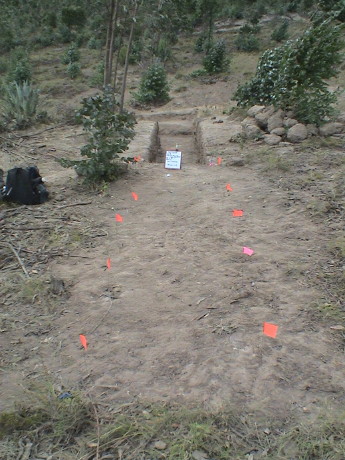 This morning, I was back at
Loma Sandoval. We opened up this new unit to extend our previous three
units to look for the surface of the pyramid.
This morning, I was back at
Loma Sandoval. We opened up this new unit to extend our previous three
units to look for the surface of the pyramid.
The wind at Loma Sandoval was really heavy this morning. We had sustained winds of about 30 knots and gusts higher than that. When a gust blew through, the best one could do was turn one's back to the wind and close one's eyes until it subsided. This was the first day that we used dust masks due to the blowing dirt.
We dug about 20 cm deep over most of the area of the unit before I tweaked my lower back lifting buckets of dirt. I called it quits for the day and Micah drove me back to the Hacienda for some rest. It's not hurt real bad, but it's at a spot that I injured before and I don't want it to get worse. The original injury was hurting me big time for months before it "healed" a couple of months ago.
By evening, it became clear that I will not be doing any heavy work tomorrow. I'll probably stay in the Hacienda all day and try to be useful somehow.
After dinner, Sandy and I came back to the room and lit a fire as there is no lecture tonight. The Hacienda provides firewood and kindling, but it is all eucalyptus which is not the best firewood around. However, virtually every tree here is eucalyptus, an introduced species. It burns fast and hot, but doesn't have much staying power. The active fire will burn down in about an hour from the last time it is fed although there will usually be some coals still glowing by the morning so it does put out a little heat all night.
I didn't go to work today. Instead, I rested my back. I helped a little in the lab before lunch, first finding some artifacts from 2005 and then cleaning the dirt off artifacts from this year. After lunch, I took a nap which seemed to have helped a lot. Late in the afternoon, Sandy and I hiked up to Molinoloma to see how my back held up and to see what had happened in the two weeks since we were digging there. Sandy also wanted to get a GPS fix on the site, but her PDA battery died before she could get a reading.
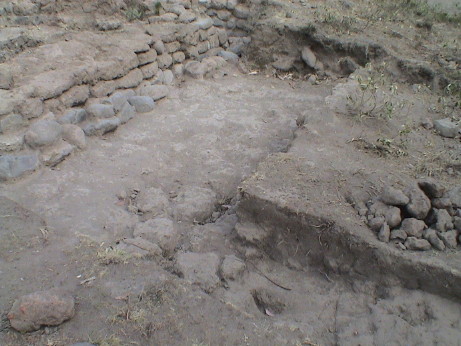 This is units 27 and
33 and part of a new unit. I worked on units 27 and 33. The new unit
exposed continuos Cangahua bedrock extending from unit 27 at the same
level as the discontinuous bedrock that was exposed in unit 27. I still
don't know if the rock we found in unit 27 was set by man or just
naturally fractured and eroded.
This is units 27 and
33 and part of a new unit. I worked on units 27 and 33. The new unit
exposed continuos Cangahua bedrock extending from unit 27 at the same
level as the discontinuous bedrock that was exposed in unit 27. I still
don't know if the rock we found in unit 27 was set by man or just
naturally fractured and eroded.
I may be able to go back to work tomorrow. We'll see what I feel like in the morning.
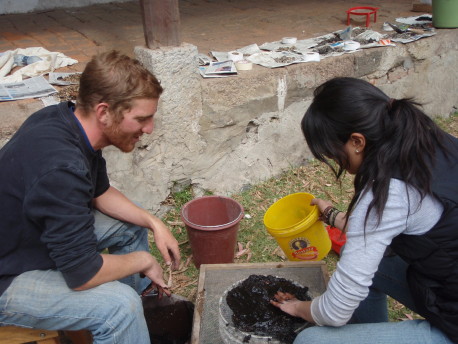 While many of
the students and staff are in the field either digging or doing
surveys, others are back in the lab cleaning and cataloging the samples
that had be excavated previously. These two students are doing part of
a "floatation" analysis were a sample of unsifted dirt is immersed in a
bucket of water. The really light stuff, seeds and such, float to the
top and are skimmed off for analysis. The rest of the mud is then
pressed through a screen to reveal all that is left. This material is
then washed to remove the rest of the dirt and the results, mostly
small stones and pottery, are examined, sorted and weighed.
While many of
the students and staff are in the field either digging or doing
surveys, others are back in the lab cleaning and cataloging the samples
that had be excavated previously. These two students are doing part of
a "floatation" analysis were a sample of unsifted dirt is immersed in a
bucket of water. The really light stuff, seeds and such, float to the
top and are skimmed off for analysis. The rest of the mud is then
pressed through a screen to reveal all that is left. This material is
then washed to remove the rest of the dirt and the results, mostly
small stones and pottery, are examined, sorted and weighed.
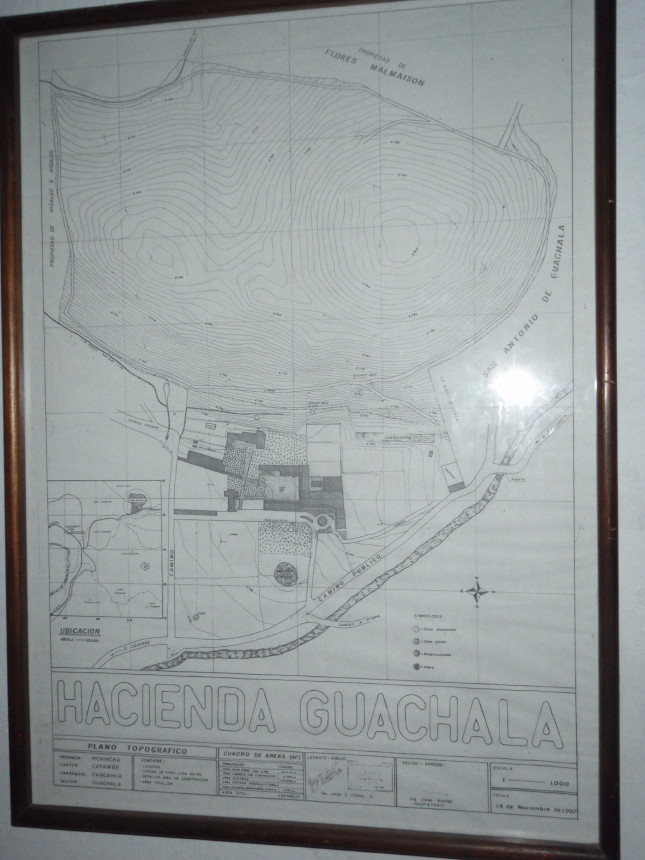 This highly detailed
topographical map is posted on the wall of the Hacienda near the
office. It is in a location that is difficult to photograph due to
reflections from the glass sheet covering the map. However, the map
itself is very interesting because it has much more topographical
detail than any other available topographical maps. Molinoloma is the
hill in the upper right region of the map represented by a closed
circle of topographical contour. The units up there are closed now, but
the excavations are still there. We went up there again this morning
with a couple of students to retrieve some screens, screen legs and a
pile of trash that were left up there. The screens and legs could be
useful elsewhere but we also recovered more than 50 heavy duty nails
that were used to stake out units.
This highly detailed
topographical map is posted on the wall of the Hacienda near the
office. It is in a location that is difficult to photograph due to
reflections from the glass sheet covering the map. However, the map
itself is very interesting because it has much more topographical
detail than any other available topographical maps. Molinoloma is the
hill in the upper right region of the map represented by a closed
circle of topographical contour. The units up there are closed now, but
the excavations are still there. We went up there again this morning
with a couple of students to retrieve some screens, screen legs and a
pile of trash that were left up there. The screens and legs could be
useful elsewhere but we also recovered more than 50 heavy duty nails
that were used to stake out units.
To get up there we hike from the little circle in the Hacienda driveway east through a pasture, by the pig pen and up a road going up the west side of the hill. We take a switchback for a short distance and then cut straight up the side to the hill to the top.
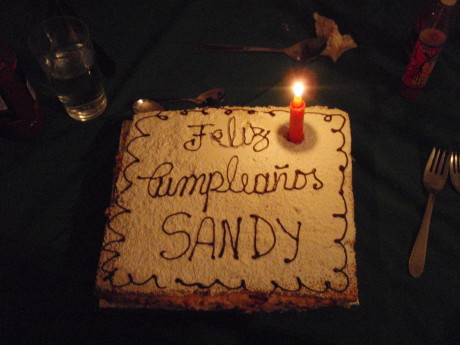 Yesterday
was Sandy's birthday. As is traditional for birthdays during the
project, she got a birthday cake and a little celebration.
Yesterday
was Sandy's birthday. As is traditional for birthdays during the
project, she got a birthday cake and a little celebration.
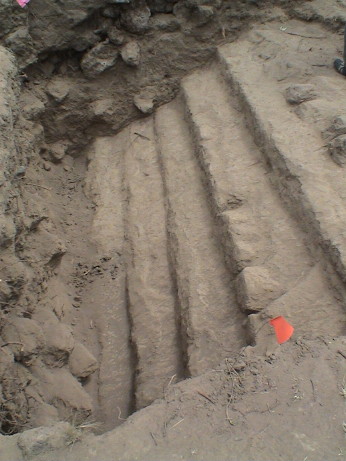 After lunch, Sam
drove Sandy and I to Loma Sandoval to see what had happened in the days
that I was in recuperation. They have made A LOT of progress and
actually found the terraces of one part of the pyramid in a non-eroded
form. This area has been buried for hundreds of years and the blocks
and mortar used to make the steps is mostly intact.
After lunch, Sam
drove Sandy and I to Loma Sandoval to see what had happened in the days
that I was in recuperation. They have made A LOT of progress and
actually found the terraces of one part of the pyramid in a non-eroded
form. This area has been buried for hundreds of years and the blocks
and mortar used to make the steps is mostly intact.
The ground penetrating radar (GPR) crew was at work too for the first time on this site. They were mapping out a 30 x 50 meter grid just northwest of the edge of the pyramid looking for locations of the other edges.
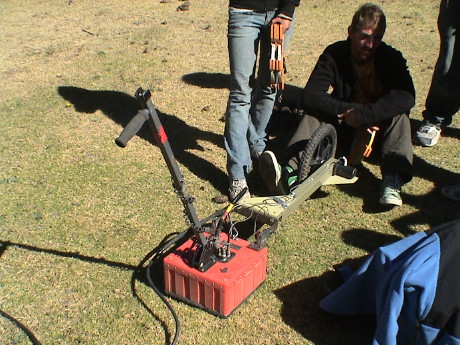 I still don't trust my back enough to go back Loma Sandoval although
it's a lot better. Instead, I went out to help the GPR (ground
penetrating radar) team on the soccer field/horse pasture on the south
part of the Hacienda property. Haciendas were often built on Inca or
pre-Inka sites often because this was the nicest property around with
flat land and a steady water supply. There are suspected Inka sites
near the church/museum as well.
I still don't trust my back enough to go back Loma Sandoval although
it's a lot better. Instead, I went out to help the GPR (ground
penetrating radar) team on the soccer field/horse pasture on the south
part of the Hacienda property. Haciendas were often built on Inca or
pre-Inka sites often because this was the nicest property around with
flat land and a steady water supply. There are suspected Inka sites
near the church/museum as well.
The radar device itself is the orange box in the photo. It is dragged along the ground and radiates a radio frequency pulse into the ground and then listens for a returned reflection from objects and strata below. It's depth capability is maybe 15 ft or so. The wheel is attached to an encoder that measures distance. The radar is triggered by movement so that it transmits about 40 pulses per meter of travel.
The radar unit is connected via a long umbilical cable to a computer that records the data. The whole works is powered by a car battery.
This receiver is tuned to a band centered around 400 MHz with sensitivity to about an octave on either side. The wavelength of 400 MHz is 75 cm but the depth resolution is much better than that so that the transmitter pulse must be much shorter than a single wavelength. This implies that the transmitted pulse probably approximates an impulse. An impulse is an infinitely sharp and short burst of energy with theoretically infinite bandwidth. The real pulse is probably a sub-nanosecond pulse with as sharp an edge as can reasonably be obtained.
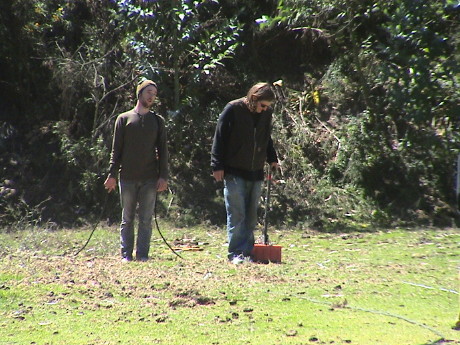 The unit itself is dragged along a grid pattern with parallel tracks
about a half meter apart. We laid out tapes on the soccer field in a 25
by 50 meter area and the unit is simply dragged in a raster pattern
over the field. Some initial test runs were done as I dragged the thing
along an arbitrary pattern to "calibrate" the field so that the
instrument would provide the best resolution. Something showed up in
those two test runs. Then the students, shown here, dragged it along
the grid pattern recording one data file per pass. Then Sarah, the GPR
expert, takes the data files and processes them into images of the
subsurface features.
The unit itself is dragged along a grid pattern with parallel tracks
about a half meter apart. We laid out tapes on the soccer field in a 25
by 50 meter area and the unit is simply dragged in a raster pattern
over the field. Some initial test runs were done as I dragged the thing
along an arbitrary pattern to "calibrate" the field so that the
instrument would provide the best resolution. Something showed up in
those two test runs. Then the students, shown here, dragged it along
the grid pattern recording one data file per pass. Then Sarah, the GPR
expert, takes the data files and processes them into images of the
subsurface features.
The field itself is covered with horse manure. This is not a big problem but the lumps can roll under the radar and lift it from the ground. This messes up the radar returns somewhat so we try to kick the stuff out of the path of the radar. I can now add "shit kicker" to my resume.
Yesterday, Loma Sandoval was scanned and some interesting features were located that bear investigation later. Sarah also scanned the surface near the steps that were already uncovered so that she could see what steps looked like in the images. I have not seen those images, but they did show up. I expect that we will see some of that data when she does her lecture on GPR this evening.
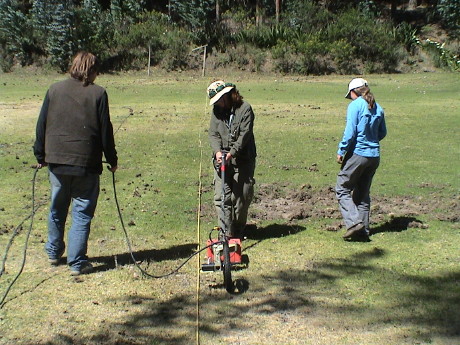 After lunch, we finished scanning the soccer field. Sandy did three
two way scans, then I did the last three two way scans.
After lunch, we finished scanning the soccer field. Sandy did three
two way scans, then I did the last three two way scans.
Then we packed up the gear and returned to the lab to copy the data off the GPR control computer onto Sarah's MacBook so that she could process the data. The ruggedized control computer runs DOS so that it can't do much of anything at all. Sarah uses some Windows XP based image processing software running in a virtualized XP environment on the MacBook to do the heavy image processing. However, she didn't have time to finish it before she had to catch the bus to Cangahua. I expect that we'll see some of the results of these scans this evening as well.
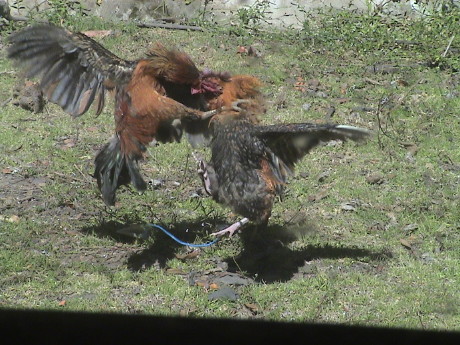 While the data
processing was going on in the lab, two roosters elected to pick a
fight in the pen outside the lab. These two went at it for over 20
minutes. The larger one looked to be winning early in the fight, but
apparently the smaller one apparently had a plan. It started running
around apparently running away from the larger one. However, I think
that it was trying to run the larger one out of energy. When the
chasing eventually stopped and the larger one turned it's back, the
smaller one jumped it from behind. Eventually the smaller one prevailed
and the larger one broke off the fight. Neither looked to be seriously
injured in this particular encounter.
While the data
processing was going on in the lab, two roosters elected to pick a
fight in the pen outside the lab. These two went at it for over 20
minutes. The larger one looked to be winning early in the fight, but
apparently the smaller one apparently had a plan. It started running
around apparently running away from the larger one. However, I think
that it was trying to run the larger one out of energy. When the
chasing eventually stopped and the larger one turned it's back, the
smaller one jumped it from behind. Eventually the smaller one prevailed
and the larger one broke off the fight. Neither looked to be seriously
injured in this particular encounter.
Toady is a half day on the sites, the afternoon is open. Tomorrow is a field trip to somewhere depending on which roads are open. There are still some disputes going on between communities and the locals may still have some roads blocked.
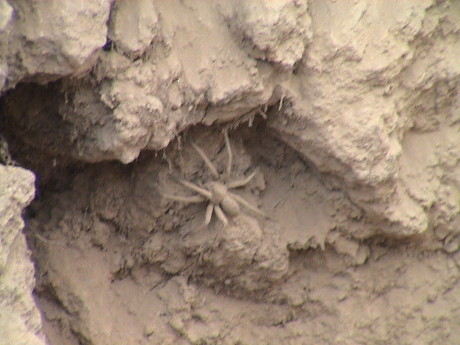 Sandy and I went back out to
Loma Sandoval with Sarah to help with some more GPR work. She wanted to
rescan an area that she did before but with the scans set orthogonal to
the previous set. There were two students helping so Sandy and I
stepped into background tasks so that the students could experience
actually operating the equipment and taking the data.
Sandy and I went back out to
Loma Sandoval with Sarah to help with some more GPR work. She wanted to
rescan an area that she did before but with the scans set orthogonal to
the previous set. There were two students helping so Sandy and I
stepped into background tasks so that the students could experience
actually operating the equipment and taking the data.
In the next unit, the students were profiling the walls and they ran across this spider about 2 meters down from the surface. It is about 2" across and startled one of the students.
The last time that Sarah was here, she also scanned a large area which we believe may be the top of the pyramid. She identified a mass of material in the scans and a unit was opened there. The mass turned out to be a bunch of Cangahua blocks piled up and buried. However, these obviously had not been there for long so we suspect that they were covering something. A 3 x 4 meter section had been dug down below the pile of blocks and a flat surface created so we scanned that new surface again. Sarah identified some more objects about a half meter down so the crew started digging again.
About this time, Sandy and I elected to hike back to the Hacienda via a dirt road that ran above the site and headed back in the right general direction. As it turned out, in about two miles, the road ran us back to a spot right across the main road from the Hacienda.
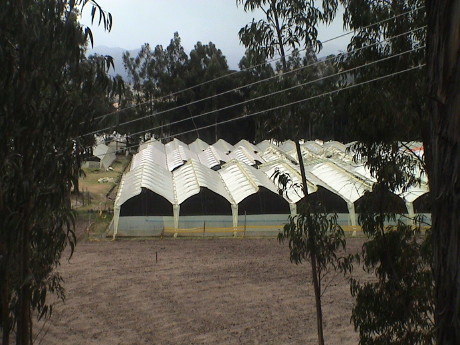 On the way, we
passed this rose farm. The soil and growing conditions here are just
right for roses so farms like these dot the landscape. Roses are big
business here employing 50 to 80 local workers each. Roses grown here
are in European flower shops in less than 36 hours from being cut.
On the way, we
passed this rose farm. The soil and growing conditions here are just
right for roses so farms like these dot the landscape. Roses are big
business here employing 50 to 80 local workers each. Roses grown here
are in European flower shops in less than 36 hours from being cut.
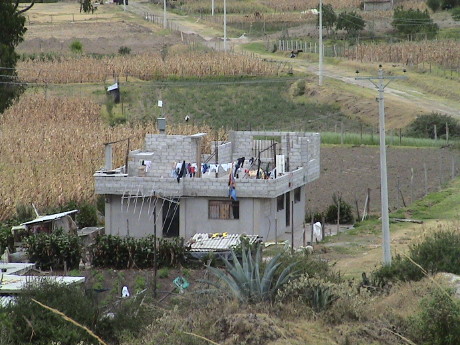 Much of the
road was through hilly back country, but it came out into the open
above some farm land. This is a farm house that is nicer than most of
them. It is built to accept a 2nd story should the owner elect to add
on.
Much of the
road was through hilly back country, but it came out into the open
above some farm land. This is a farm house that is nicer than most of
them. It is built to accept a 2nd story should the owner elect to add
on.
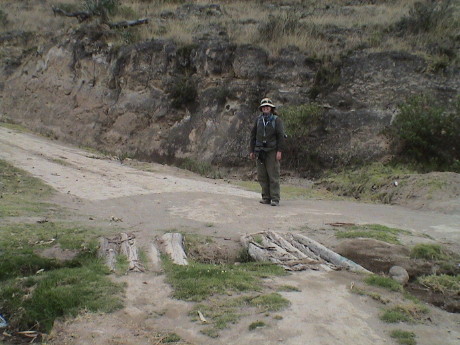 At this
bridge, the road forked. We came down from the right took the fork that
the picture was taken from. It headed directly to the Hacienda which we
could barely see through the trees from there.
At this
bridge, the road forked. We came down from the right took the fork that
the picture was taken from. It headed directly to the Hacienda which we
could barely see through the trees from there.
The "bridge" is obviously a locally built structure. This entire road structure is probably maintained by the people that use the road.
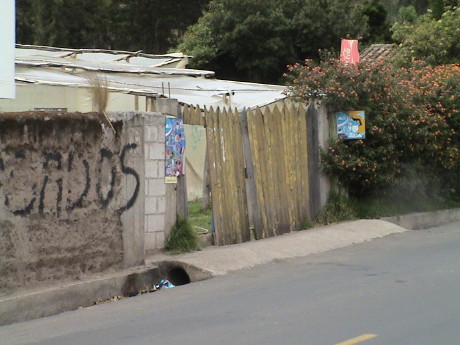 Where the
road almost reached the main paved road at the Hacienda driveway, we
walked through an opening in a fence and crossed a small stream to
reach the paved road. We then walked up the road a ways to the little
village just uphill from the Hacienda and found this little store. It
was just an open door in a gate with a small sign advertising ice cream
next to it. I bought a 1.25 liter bottle of orange juice for $0.95. We
then walked back to the Hacienda. Overall, our walk was about 2.5 miles
based on my pedometer reading.
Where the
road almost reached the main paved road at the Hacienda driveway, we
walked through an opening in a fence and crossed a small stream to
reach the paved road. We then walked up the road a ways to the little
village just uphill from the Hacienda and found this little store. It
was just an open door in a gate with a small sign advertising ice cream
next to it. I bought a 1.25 liter bottle of orange juice for $0.95. We
then walked back to the Hacienda. Overall, our walk was about 2.5 miles
based on my pedometer reading.
Later in the afternoon, we took the bus to Cayambe to buy some more stuff (chocolate, cookies, bread, hot sauce, and diet coke) at the Gran Aki. It took our typical 1 hour and 40 minutes to make the round trip. While we were there, we saw some of the Foothill students stocking up on rum and Doritos so I have a pretty good idea of what they have in mind for tonight. There is a middle school dance scheduled at the Casa this evening, but we are staying at the Hacienda to sit by a warm fireplace.
Sandy has had a breakthrough moment in her work with ArcGIS and she is obsessed with solving that "one last problem" with the maps. It turns out that due to a combination of things, being on the equator AND at 78° longitude at the same time AND using the high resolution map set provided by the Ecuadorian government produces a worst case condition. Our location meets all three conditions. She's been solving a series of problems all along, but this has taken so much time that she might not be able to finish her project before she loses access to the ArcGIS software. We'll have to investigate getting access again through CSU Fullerton or maybe someplace else when we get home.
Tomorrow is a field trip to some hot springs just over the Amazon side of the Andes. We'll be on the trip most of the day.
© 2009 George Schreyer
Created 12 Jul 09
Last Updated July 18, 2009